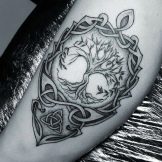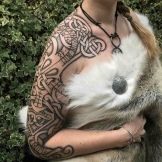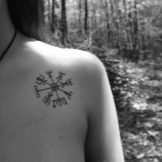Scandinavian style tattoo overview

The culture and traditions of the inhabitants of ancient Scandinavia today are experiencing a surge of interest. Viking campaigns and raids, mysterious runes, legends and myths - all this became the basis for films, TV series and books. It is not surprising that Scandinavian tattoos are widely in demand among our contemporaries.

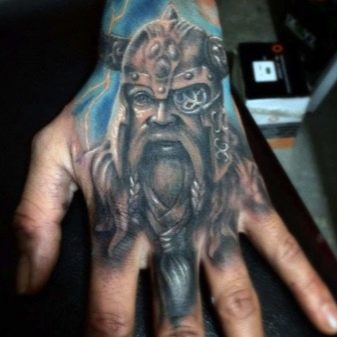
Peculiarities
Headwear with a Scandinavian theme can be called a trend in recent years. Many representatives of the stronger sex are close to the philosophy of the Vikings - their bravery, courage and the images of the most desperate warriors are beaten in the famous movies and TV series. Northern mythology formed the basis of cult literary works. For example, the public is very fond of the image of Ragnar Lothbrok from the "Vikings" saga, and his tattoos have become a source of inspiration for many men around the world.
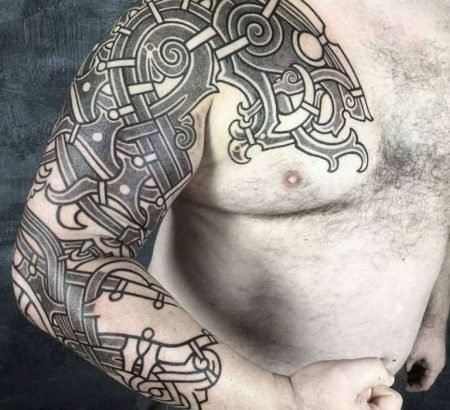
Let's turn to history. Vikings are the ancestors of modern Icelanders, Swedes, Norwegians and Danes. The era of their raids and sea voyages fell on the VIII-XII centuries. They made all their campaigns solely for the sake of robbery, but they went down in history not only as robbers. Their achievements are of great importance: it was the Nordic peoples who made the very first voyage across the Atlantic, created the runic alphabet and wrote many interesting myths and legends.
Information about Scandinavian tattoos reached contemporaries thanks to the works of historians who studied the Arab and Byzantine chronicles, some of the data were provided by travelers and merchants.
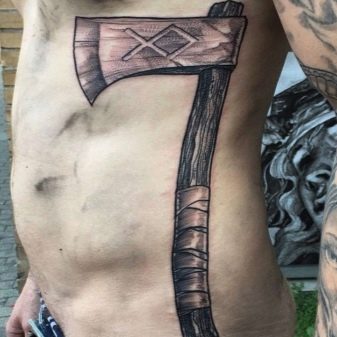
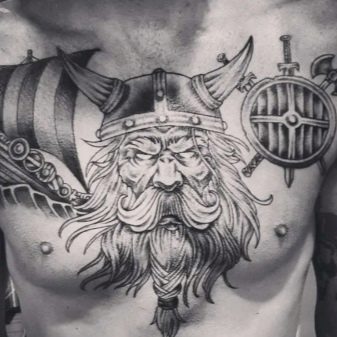
According to the information received, the Vikings used tattoos in order to express their faith and emphasize status.So, in the famous work of the Arab traveler Ahmad ibn Fadlan, the Vikings are described as men covered with tattoos from nails to the very neck.
A surge of interest in the traditions of the ancient Scandinavians arose in the middle of the 19th century, this period in history was called the "era of Scottish romanticism." It was then that Wagner's famous opera The Ring of the Nibelungen was created. The plot of this piece of music is based on the northern legends about Odin and Loki, the warrior Siegfried, the Valkyries and other pagan heroes.

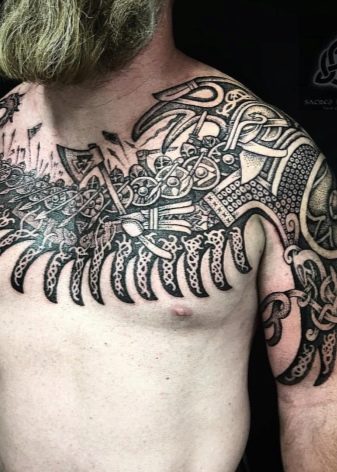
Scandinavian tattoos are most often chosen by men. And this is not surprising, since the qualities praised by this nation have been truly masculine from time immemorial - these are physical strength, courage, despair and readiness to rush into battle at any moment to protect their interests. Such tattoos are worn by people prone to dominance and leadership.
However, Scandinavian fashion has also touched the fair sex. Nowadays, it is not uncommon for girls to have all kinds of runic symbols, amulets and ornaments written on their bodies. There is a simple explanation for this - during the time of the Vikings, women fought in battles on an equal footing with men, they repelled enemy raids and rushed to attack. The concept of their independence and equal rights came to the liking of many of our contemporaries.
That is why, when choosing a sketch for a tattoo, the fair sex is increasingly turning to northern motives.
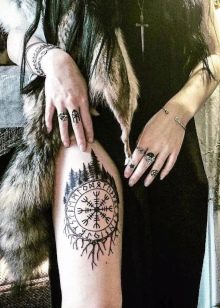
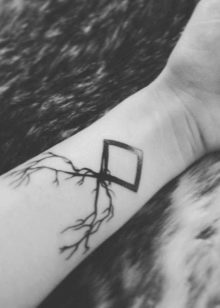

Types of tattoos and sketches
Thanks to the popularity of Viking series in recent years, Nordic tattoos have literally burst into the world of tattoo art. Men prefer this symbolism for many reasons:
- if these are runic symbols, then they can affect the character of the owner of the tattoo, change his karma and consciousness;
- if these are drawings of divine essences, then they act as a talisman and amulet, endow with magical power;
- if they are heroes of myths and legends, then they associate the owner of the tattoo with courage, courage and tremendous physical strength;
- if these are patterns, then they will become an amulet of a person, protect him from mental weakness, save him from the action of dark forces;
- if these are images of animals, then they will become a kind of association that characterizes the character of the owner of the tattoo.



For many men, Scandinavian mythology in general and tattoos in particular have become an integral part of a charismatic image.
Practice shows that runes, images of mythical characters and gods give many self-confidence and add attractiveness to the opposite sex.
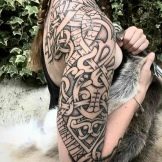
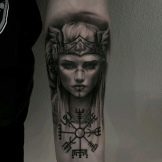
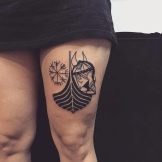
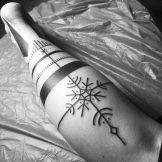
Let us dwell in more detail on the most popular northern subjects realized in body painting.
Heroes of mythology
The winged Valkyries are known far beyond the Scandinavian countries thanks to Nordic legends and traditions. It is believed that it was a great honor for the warriors to die in battle, and it was the warrior maidens who carried the dead warriors to the realm of the dead. A tattoo depicting these mythical characters indicates the honor, courage and military recklessness of a person, his willingness to fight to the very end.
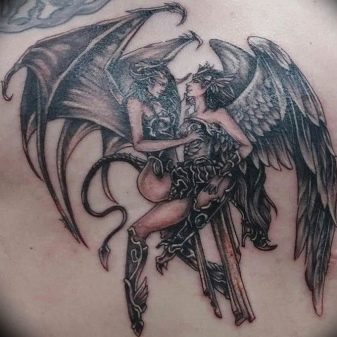
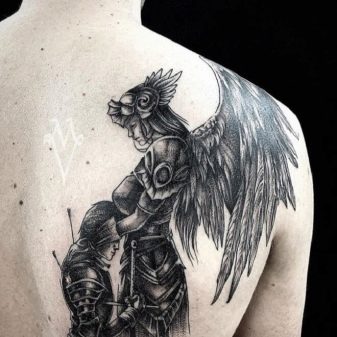
Not spared the fashion for northern tattoos and the Vikings themselves. However, their interpretation largely depends on the additional subjects of the plot composition. For example, a Viking with a boat in the past was considered a sign of returning home, the approach of the end of a long journey. Today, he has become the personification of courage, strength, determination and courage.
A Viking holding an ax in his hand symbolizes the balance between physical strength and spiritual essence, personifies unity with nature. If, at the same time, a helmet is depicted on a warrior, then such a tattoo will become a sign of reliability and security.
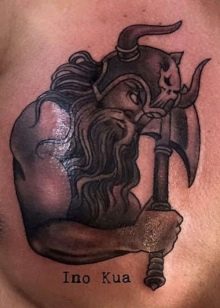
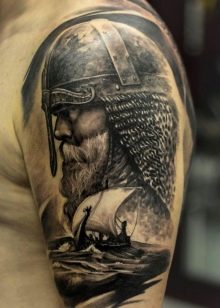
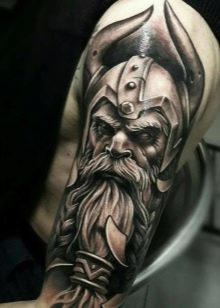
A viking and a bear within the same tattoo simulate justice and wisdom of a man, indicate the fearlessness of its owner.
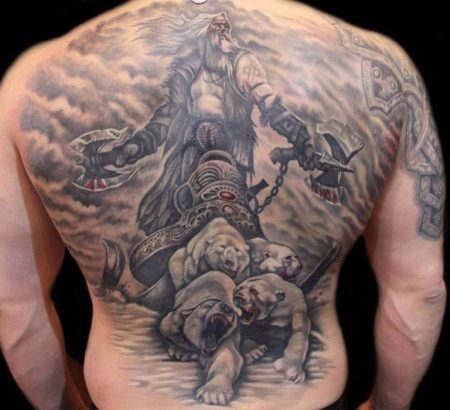
Gods
The Vikings were pagans. The most revered deity for them was Odin. This is an intelligent creator and universal father, in one person he is a warrior, a sorcerer, and a shaman. In tattoos, he is stuffed without an eye - according to legend, Odin gave it in exchange for wisdom.
The faithful companions of this deity are the ravens Hugin and Munin, a pair of wolves named Geri and Freki, as well as the eight-legged horse Sleipnir. In his hands, Odin invariably holds the spear of Gungnir, which did not know a single miss.
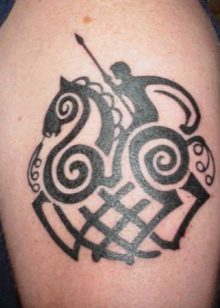
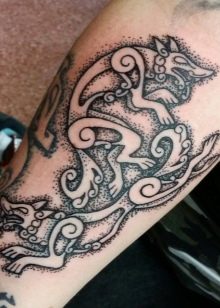
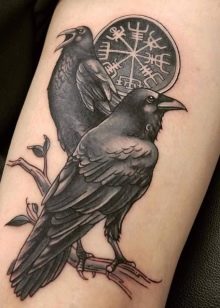
Tattoo with the supreme deity of the ancestors modern Scandinavians are optimal for men seeking patronage from above. These are people who honor the forefather and want to adopt all his qualities. The most harmonious image of Odin looks on the body of brave and wise men, ready to take risks, leaders in all their manifestations.
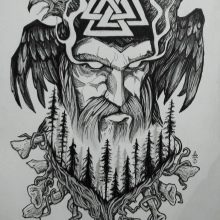
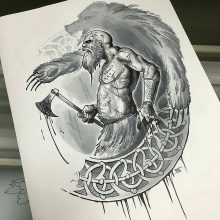

Animals
Popular image of Sleipnir - the faithful horse of Odin with eight legs. Such a tattoo is a reference to the mind, wisdom, the desire to move only forward. Such a tattoo is most harmonious on people with a powerful inner core and an active lifestyle.
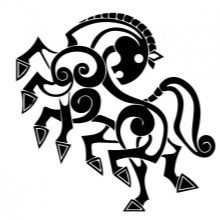
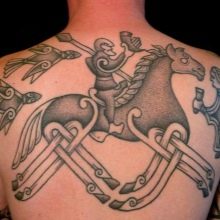
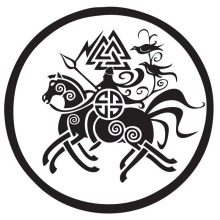
Odin's crows became a common theme in Scandinavian tattoos. In general, the image of ravens in ancient northern mythology is a metaphor that connects thought and memory. According to legends, these birds fly all over the world and help people learn about its structure.


Such a tattoo indicates a person who is inclined to search for truth, knowledge of universal wisdom. She suits balanced and reasonable people.
Also, crows are considered symbols of connection with the other world, therefore, such a tattoo is often applied in memory of departed relatives. The depiction of a wolf can also have a sad context. In the plot composition of Scandinavian tattoos, this animal speaks of a strong sense of loneliness that its owner experiences.
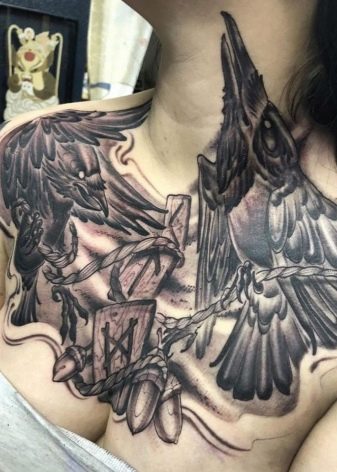
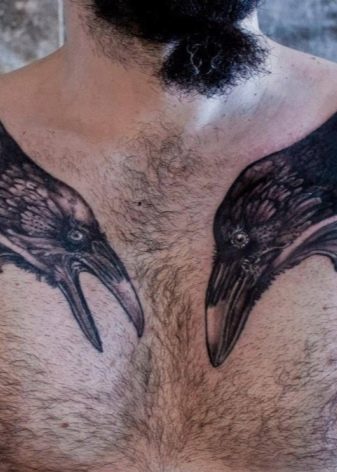
Patterns and ornaments
In the art of body art, Scandinavian ornaments are well known. In ancient times, they decorated the weapons and armor of the Vikings. It was they who became the basis for the creation of the first wearable drawings of this militant people.
Scandinavian ornaments resembled Celtic ones in their appearance, in the same way they carried a deep mystical meaning. It was believed that such a tattoo has the power to protect its wearer in battle, attracts wealth and the disposition of the deities to him. Nowadays, such tattoos can be used as a talisman or amulet, but most often they have an exclusively aesthetic function.
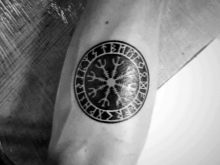
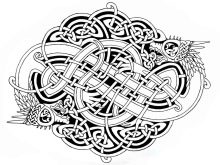

As patterns, the most popular theme is related to runes. The creation of these symbols pursued a twofold goal: on the one hand, the runes formed the basis of the writing system, and on the other, they carried a deep message. Runes were revered as a mystical sign. Northern legends say that God Odin even sacrificed himself for the sake of possessing these signs.
Runic ties are considered a separate type of tattoos with runes.
Unlike simple runes, they are not an independent symbol, but a combination of several signs. Depending on the combinations used, they acquire a new meaning and can be beneficial to their owner.
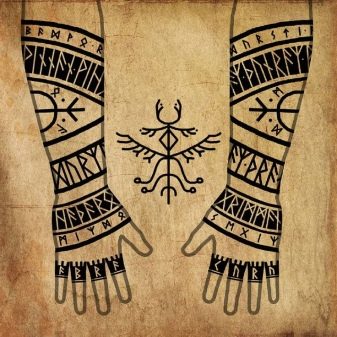

Keep in mind: each rune contains a certain energetic message that affects the fate of a person. Therefore, it is not recommended to fill yourself with a mystical symbol, guided only by the appearance of the image. Before getting a tattoo, you should carefully study the meaning of each sign - not all runes carry positive interpretations, many of them contain a charge of aggression and cruelty.
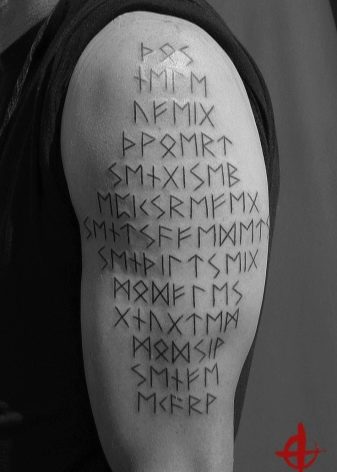

Other popular subjects.
- World Tree. In Viking legends, this is an ash of a gigantic size. According to ancient legends, such a tree has the property of connecting different worlds and is a reflection of the general structure of the vast Universe. At the top of an ash tree, an eagle is depicted, personifying the mind, a dragon is hiding in the roots, embodying power and strength.Deer are drawn near the branches, and squirrels are jumping along the trunk. Such a tattoo indicates a person who is interested in northern traditions, myths and legends of the Nordic peoples. The bearer of such a tattoo studies the Universe, strives for the knowledge of the highest wisdom and finding the right spiritual path.

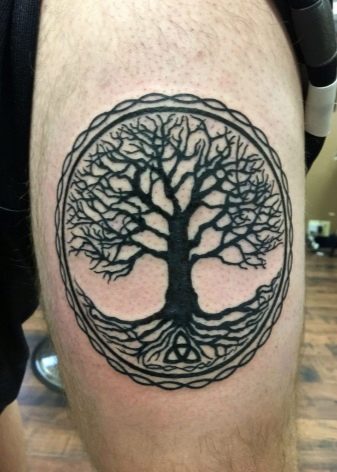
- Viking ship. Historical facts show that the northern peoples became famous as brave seafarers. They built ships and sailed across the Atlantic Ocean, managing to get to the Mediterranean Sea. There is a version that the Nords discovered America long before the memorable expedition of Christopher Columbus. The image of their ship on the body personifies the love of novelty, the desire for discovery, the conquest of unconquered lands. In ancient times, ships were operated by a whole team. In our reality, this can become an allegory - such a tattoo suggests that each person creates his own destiny, but without the support of his family he is unlikely to be able to achieve what he wants.
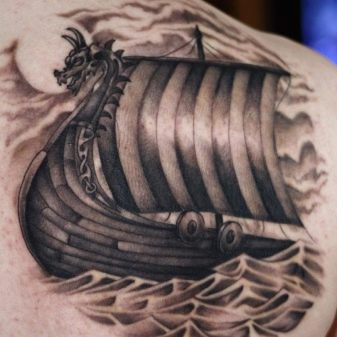

- Runic compass. Another symbol of the ancestors of modern Scandinavians is also associated with navigation - a compass. The northern peoples believed that such a tattoo would bring good luck during long wanderings, help to stay on track, and provide protection and patronage of higher powers.
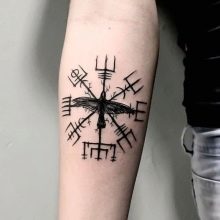
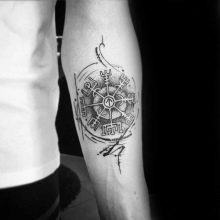

- Thor's hammer. In northern mythology, Thor was the son of Odin, the protector of all deities, a thunderer. Its hammer was so heavy that only its owner could lift it. At the blow of this hammer, thunder shook the earth and lightning flashed, and the image of this weapon has long been one of the most popular amulets in Scandinavia. People wore a mini-hammer around their necks, blessed weddings with them and put them under the bed of the newlyweds so that they would have many descendants. Nowadays, a tattoo in the form of a hammer has become a kind of amulet that provides protection and patronage of one of the most powerful gods. In addition, the hammer personifies the cyclical nature of destruction and restoration, as it helped not only to kill, but also to resurrect.
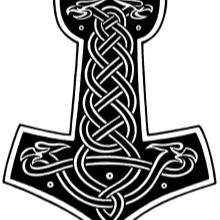
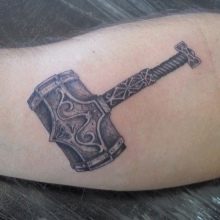
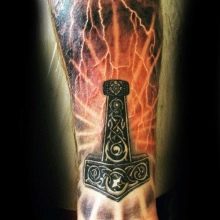
Styles and colors
Various styles are used when creating nordic tattoos. The following solutions are most in demand:
- realism - popular when creating images of deities, mysterious creatures, warriors, as well as birds and animals;
- tribal / linework - relevant for creating ornaments, patterns and complex combinations based on them;
- graphics - will be indispensable when filling large volumetric compositions based on mythological plots;
- blackwork is a brutal and gloomy style that perfectly reflects the very nature of the Vikings;
- minimalism - used when the tattoo is pierced on a small area of the body.


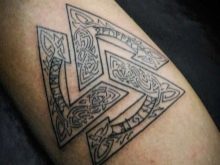
The style of Scandinavian tattoos is based on the principle of monochrome. Usually black pigment is used, and the natural color of the skin becomes the background for the composition. This laconic coloring allows you to bring great artistic expression to the image. The density of the filling is very important. There should be no free skin areas in the tattooing area.
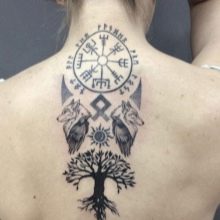
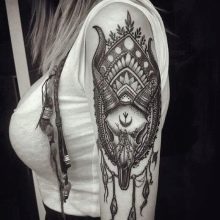
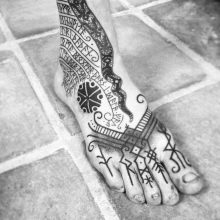
Experienced craftsmen necessarily adhere to the principle of multi-figuredness, scale. This means that the very best tattoo designs include dozens of different elements.
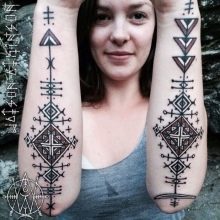
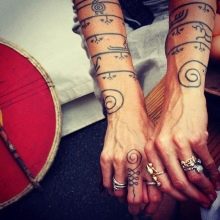
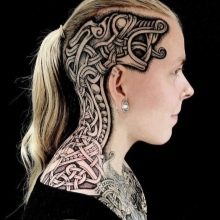
Selection and accommodation options
At first glance, it may seem that the tattoo can be applied to any free area of the body. However, this is not the case. The location of the tattoo carries a deep message and gives a special interpretation of the wearable pattern. The northern motifs are based on voluminous complex sketches that occupy the back, sternum and arm. Less often miniature scenes are used in the most secret places.
- Shoulder... A tattoo depicting ancient warriors or Scandinavian gods, personifying courage and strength, looks especially impressive on the shoulder. Such drawings create additional protection for a man.
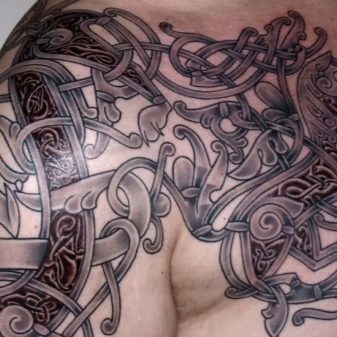

- Forearm... This is a versatile medium sized tattoo area.Usually, images of mystical runes and plots from northern mythology are stuffed in this place.
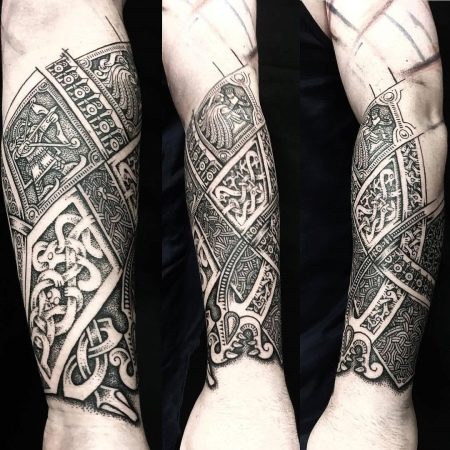
- Wrist... There is not much room for a tattoo here. Therefore, small symbols will be organic in this area - usually these are runes or a bracelet in the form of a ligature ornament.
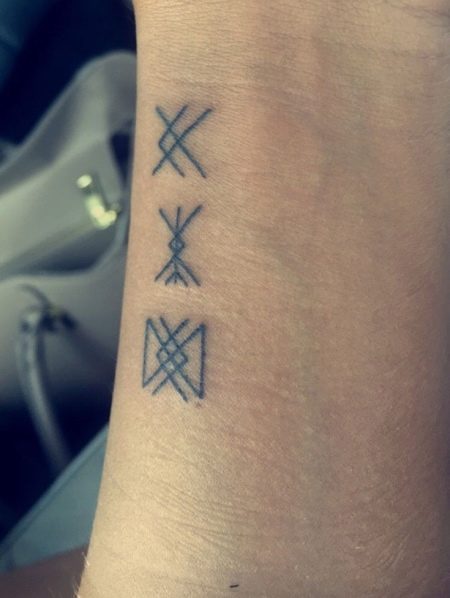
- Palm... A tattoo with a personal connotation is usually pierced on the palm of your hand - these can be mysterious signs and inscriptions, as well as attributes that are designed to enhance masculine qualities. The application of miniature patterns is allowed on the fingers, the Brush is most often used for printing ornaments.
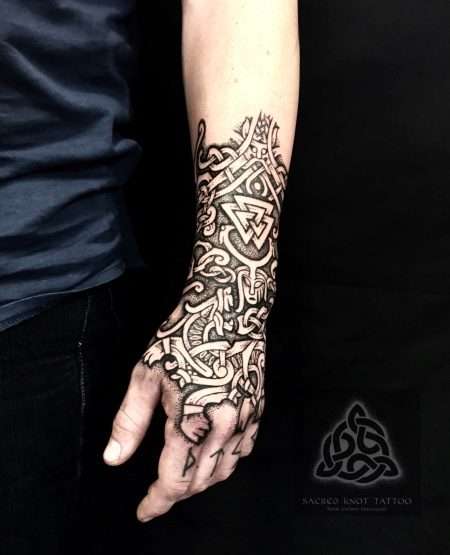
- "Sleeve". The classic version of the Scandinavian tattoo is considered to be a "sleeve" - this is a pattern that completely covers the arm with its patterns. Typically, the "sleeve" consists of complex compositions and includes several images framed by patterns.
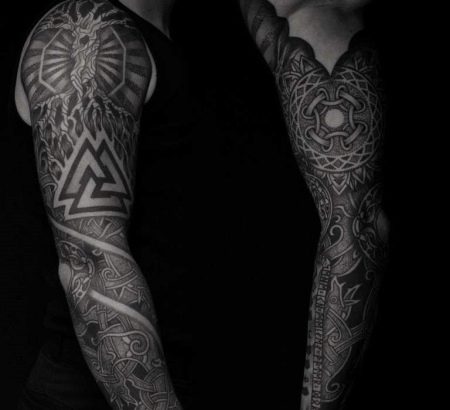
- Neck... In this place, miniature tattoos are pierced, but at the same time, each of them carries the deepest sacred meaning. Most often, runes and inscriptions are depicted here. It is believed that they work much more efficiently if they are stuffed near the head.
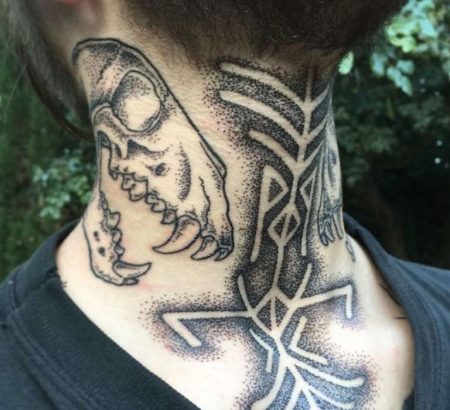
- Breast... The chest depicts pictures of wild animals, ravens, characters and creatures from Nordic mythology.
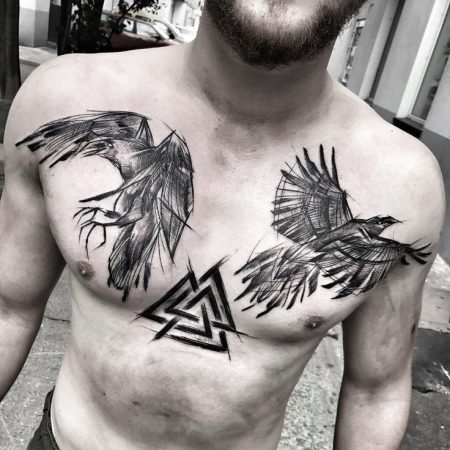
- Side... Drawings with a great philosophical context are stuffed on the side of the case. A good solution for this zone will be a Nordic ship or a tree of life. Such images will be a reference to the search for truth and finding oneself.
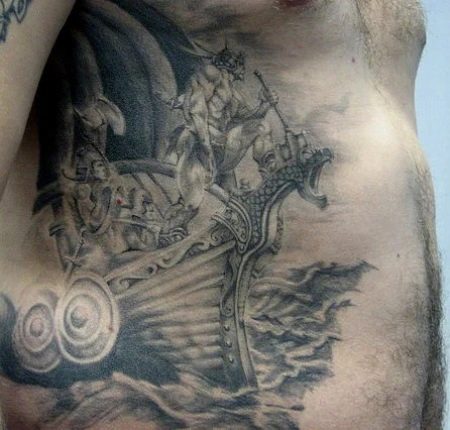
- Hip... Initially, northern thigh tattoos were not applied. However, in our time, this zone is used by representatives of the female half of humanity. Most often, patterns and intricate ornaments based on runes are stuffed here.
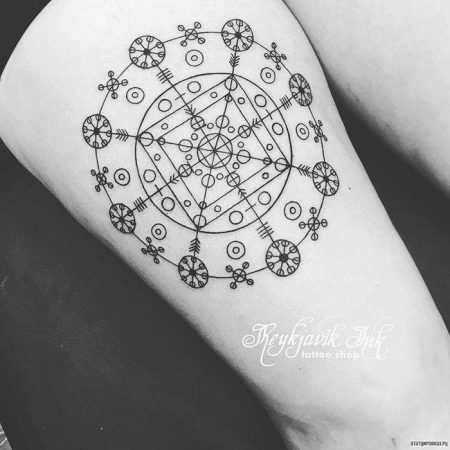
- Back... A voluminous canvas that gives room to the imagination. Large compositions and large-scale sketches are stuffed here. Pictures from myths and legends are appropriate, compositions from deities, warriors, birds and animals look good. To enhance the semantic message, additions are introduced into tattoos in the form of old inscriptions.

- Scapula... On the shoulder blades, a runic compass, a miniature pattern or a drawing from Scandinavian mythology will be appropriate.
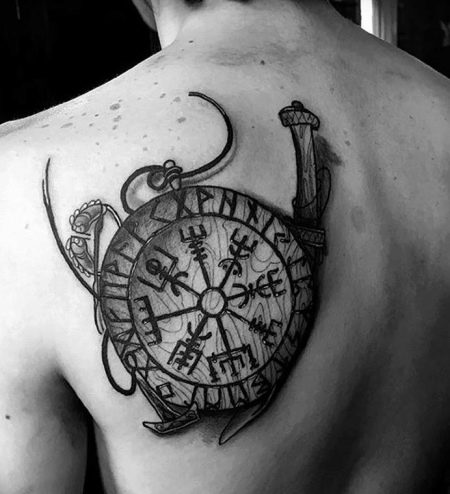
- Leg... Tattoos on the legs are pierced in the form of ornaments. Women more often draw runic ligature on the ankle. Men use complex ornaments, completely hammering their legs with images of gods, warriors and mythical characters.
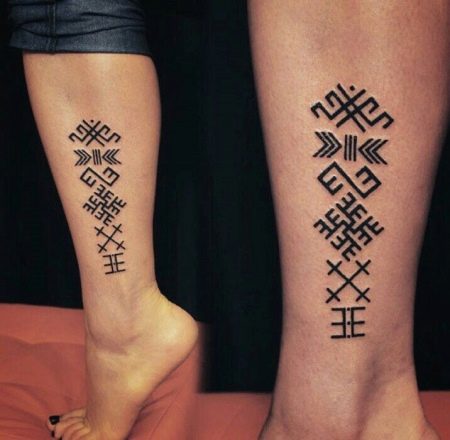
Scandinavian style hairpieces are very popular. They attract men with their brutality and charisma. It is no coincidence that tattoos with mysterious signs, images of deities and brave northern warriors are in demand today.
However, each sign of this cult has its own sacred meaning, therefore, before choosing a suitable plot, be sure to clarify its meaning.

